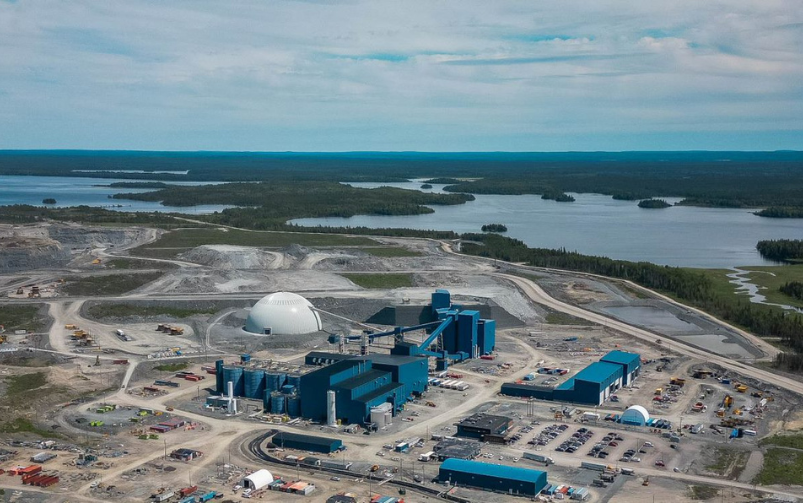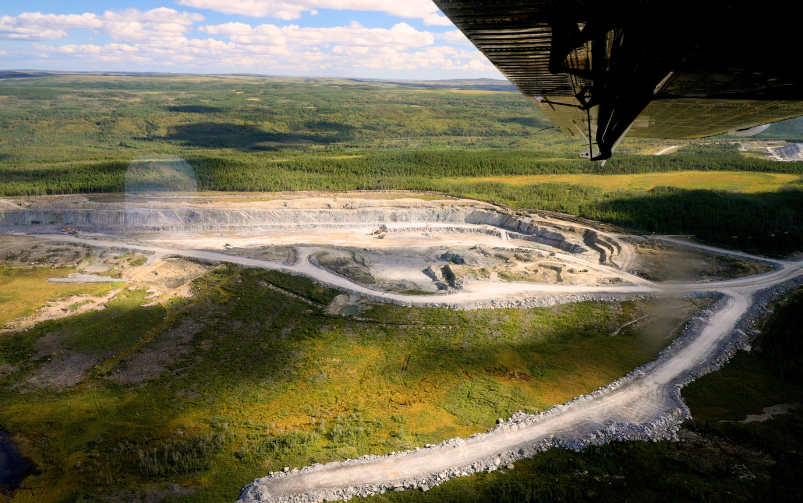Agnico Eagle Mines, whose operations include the Meliadine mine in Nunavut, advocated for the loan guarantee program, recognizing the opportunity it could provide to remote projects. Courtesy of Agnico Eagle Mines
The federal government’s forthcoming Indigenous loan guarantee program could help speed up the development of critical minerals projects across the country, while also advancing economic reconciliation, advocates of the program say. However, questions still remain about the criteria that will be used to evaluate applicants and the program’s independence from the federal government.
The program, announced in the 2024 budget, will provide up to $5 billion in loan guarantees to help Indigenous communities purchase equity stakes in major projects, and does not exclude a project in any sector from potential investment. The budget also granted an additional $3.5 million to Natural Resources Canada over two years to support capacity funding for Indigenous communities looking to apply to the program.
“This is about creating wealth, strengthening First Nations economies and raising the standard of living in First Nations communities,” said Niilo Edwards, chief executive officer of the First Nations Major Projects Coalition (FNMPC), which has advocated for a loan guarantee program since the organization’s founding in 2017. The coalition had also called for the program to be sector-agnostic, and include oil and gas projects, to allow First Nations to set their own priorities and capitalize on opportunities close to their traditional territories. “It’s a very useful tool, not only for finance, but for achieving the objectives of broader economic reconciliation,” Edwards said.
According to a Nov. 2023 press release from FNMPC, based on research it conducted that examined verified sources of information for planned projects, there are 470 major projects across Canada that will impact Indigenous land in the next decade, representing more than $525 billion in needed capital investments. Edwards said that translates to roughly $50 billion to $60 billion of Indigenous equity that could be financed.
“There’s a lot of activity in the mining and critical minerals space that needs to be developed over the next several decades, and that will only proceed with First Nations’ participation and consent,” he said.
Martin Turenne, president and CEO of FPX Nickel Corp., said that for a sector that has been “relatively starved” of capital for the past decade, “anything that can result in the flowing of capital into the industry for the next generation of projects is good for the mining industry.” He also noted that Indigenous equity participation would further advance the sector’s work to partner and collaborate with Indigenous communities.
Lowering the cost of borrowing
First Nations attempting to buy into major projects have historically been hamstrung by rules under the Indian Act that prevent First Nations governments and status individuals from using reserve land or assets as collateral. Many must borrow 100 per cent of their investment as an equity loan, leading lenders to charge interest rates that outstrip any rate of return the nation would earn.
Edwards said he expects that on a general basis, a federal loan guarantee will shave between 150 and 250 basis points off the cost of borrowing, as well as shorten the amortization period of loans, though he noted the type of project will likely influence borrowing rates—with greenfield projects, which come with construction and cost-overrun risks, most likely to be a bit more expensive. “Perhaps you’re buying into $100 million or $200 million of equity; over the lifetime of the project, that’s a significant return profile you’ve achieved by lowering the cost of borrowing,” he said.
As more deals go through, he said that he expects to see the capital markets—which on the whole are unused to lending to First Nations or their entities—get more comfortable with the profile of those transactions.
Qasim Saddique, principal consultant at Suslop Inc., a Toronto-based consultancy that specializes in sustainability strategy, project management and community development, said his firm has started to have early conversations with First Nations clients about the program. “We’ve definitely started to identify that as a major opportunity enabler,” he said. But he noted nations will have to conduct thorough due diligence of any potential project, including whether it has a lifespan that matches their investment horizon, if it is at risk of future headwinds and whether it would be financeable by the market on its own.
Within the mining context, Saddique said First Nations could invest in mining projects near or on their traditional territories, such as by coming in with the capital necessary to build part of the operation. Edwards said he has seen FNMPC members invest in the infrastructure necessary to a project with a revenue stream attached, like a transmission line or road.
For mining companies operating in remote jurisdictions, where the cost of developing a project is higher, having the equity support of a First Nation could be “very helpful,” said Alex Buchan, director of Nunavut affairs for Agnico Eagle Mines. Buchan said Agnico Eagle had advocated for the program with the federal government, and also for it to remain flexible to the various project opportunities Indigenous communities might want to pursue.
Agnico Eagle’s Nunavut operations are on Inuit-owned land and the company has signed subsurface and tenure agreements with the Kivalliq Inuit Association, as well as impact benefit agreements that include provisions for Inuit employment, training and purchasing from local contractors.
Programs across Canada
Three provinces currently have their own Indigenous loan guarantee programs. Ontario’s, launched in 2009, is focused on clean energy infrastructure, and as of March 2023, has granted $500 million in guarantees across 11 loans. The Alberta Indigenous Opportunities Corp. (AIOC), launched in 2019, has already backed seven deals that provided more than $680 million in guarantees to 42 Indigenous groups in the province.
Saskatchewan announced its own loan guarantee program in 2022, and British Columbia’s February 2024 budget promised to set up a $1 billion program.
Justin Bourque, founder and president of Âsokan Generational Developments, an Alberta-based consultancy focused on partnerships between Indigenous communities and corporations, said the deals that have resulted from AIOC-backed equity stakes have given First Nations greater visibility into the financial, environmental and regulatory performance of assets. Bourque is also the founding president of Athabasca Indigenous Investments, a partnership of 23 First Nations and Métis communities that bought an equity stake in seven Enbridge pipelines in 2022 with a loan guarantee from the AIOC, and has also been involved in multiple other AIOC-supported deals.
“From a corporate relationship, there’s information-sharing and continuity between the business and Indigenous parties that has never historically been there before between a community and a [project] proponent,” he said.
However, there are still unanswered questions about how the federal program will operate. Jason Rasevych, president of the Anishnawbe Business Professional Association (ABPA), called the budget announcement “a step in the right direction,” but said it lacks clarity around the criteria that will be used to decide which loans to guarantee, or if there will be any requirements for social impact beyond the nation’s return on investment.
He also expressed concern that the program could be susceptible to political or government agendas, and result in the majority of funds going towards nations that are more pro-resources development and opportunity-ready, but do not cater to those that are still seeking resources for basic infrastructure in their communities.
Turenne said he also wants to see more detail on what stage of projects the funding will be made available to, and the maximum ticket size for loan guarantees.
Saddique said he expects and hopes to see deal sizes “that didn’t exist in the past. If we don’t see blockbuster deals as a function of the program, there’s something architecturally not working out.”
With so many projects in the pipeline, multiple experts suggested the initial $5 billion could get used up quickly. Finance Minister Chrystia Freeland, speaking at the FNMPC conference in late April, said the amount was just a start. “Nothing would make me happier than seeing that $5 billion oversubscribed and [the federal government] needing to put in place even more,” she said.
The federal government stated more details on the program will be made available later this year.




